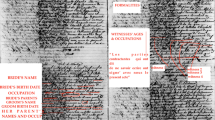Abstract
A sample of marriage registers from the parish of Liverpool St. Nicholas Church in England between 1839–1927 is used to examine changing characteristics of grooms who signed with a mark over this period. The proportion of illiterate grooms in the parish fell from about a third to under 5%. Age at marriage and likelihood of being a widower rose markedly for illiterates over the period relative to literate grooms. The percentage of illiterate grooms marrying literate brides rose markedly as well; however, in contrast with national tendencies, there was less evidence of assortative mating by literacy or of any downward trend in this for the Liverpool sample. There was no evident rise in literacy requirements for employment in the transport sector which dominated the Liverpool economy throughout the period under consideration. This implied that even in the first three decades of the 20th century with signature ability almost universal, most illiterate grooms in Liverpool were not in unskilled occupations. However, illiterate grooms were increasingly less likely over time to be in skilled manual occupations.
Similar content being viewed by others
REFERENCES
Barnes, C.B. (1915). The longshoremen. New York: Survey Research Associates.
Blalock, H.M. (1972). Social statistics (2nd ed.). New York: McGraw Hill.
Farr, W. (1975). Intermarriage of persons who can write, with those who sign by Mark. In 18th Annual Report of the General Registrar of Great Britain, reprinted in Vital Statistics: A Memorial Volume of Selections from the Reports and Writings of William Farr. Metuchen, NJ: The Scarecrow Press. (Original work published 1855)
Graff, H.J. (1979). The literacy myth. Literacy and social structure in the nineteenth-century city. New York: Academic Press.
Graff, H.J. (1987). The legacies of literacy. Continuities and contradictions in western culture and society. Bloomington, IN: Indiana University Press.
Great Britain. (1851). Census reports. London, UK: Government of Great Britain.
Great Britain. (1901). Census reports. London, UK: Government of Great Britain.
Great Britain. (1911). Census reports. London, UK: Government of Great Britain.
Great Britain. (1931). Census reports. London, UK: Government of Great Britain.
Great Britain Parliament. (1892). Minutes of Evidence taken before the Royal Commission on Labour, Industry Series Group B. London, UK: Parliament of Great Britain.
Houston, R.A. (1988). Literacy in early modern Europe. Culture & education 1500-1800. New York: Longman.
Hyde, F. (1971). Liverpool and the Mersey. An economic history of a port 1700-1970. Newton Abbott, UK: David & Charles.
Phillips, G. & Whiteside, N. (1985). Casual labour. The unemployment question in the port transport industry 1880-1970. Oxford, UK: Clarendon Press.
Taplin, E.L. (1977). Dock labour at Liverpool: Occupational structure and working conditions in the late nineteenth century. Transactions of the Historic Society of Lancashire and Cheshire for the Year 1977, 127, 133–154.
Vincent, David (1989). Literacy and popular culture. England 1750-1914. Cambridge, UK: Cambridge University Press.
Vincent, David (2000). The rise of mass literacy: Reading and writing in modern Europe. Malden, MA: Blackwell.
Author information
Authors and Affiliations
Rights and permissions
About this article
Cite this article
Mitch, D. How did Illiterates Fare as Literacy Became Almost Universal? Evidence from Nineteenth and Early Twentieth Century Liverpool. Interchange 34, 313–335 (2003). https://doi.org/10.1023/B:INCH.0000015907.20999.d9
Issue Date:
DOI: https://doi.org/10.1023/B:INCH.0000015907.20999.d9




